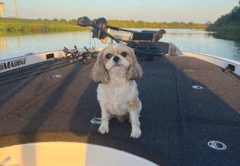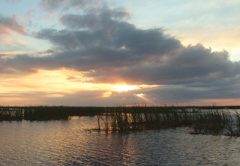In these parts of central-south Florida, the Spotted Sunfish goes by the name ‘Stumpknockers’ and sometimes lumped into the category of bream. Though the name is derived from their affinity for submerged timber in other parts of the southern United States, these members of the sunfish family are often overlooked as a viable food source.
In appearance the Spotted Sunfish are generally olive-green to brown in color with a black to reddish spot on the base of each scale forming rows of dots on its side. Their beefy wide body provides them with greater muscle strength for a hearty fight as well as nice thick fillets to eat. Their range is limited to the southeastern United States including Florida and into the central Mississippi basin. Their farthest range north would be into southeastern Tennessee and North Carolina.
They prefer habitats of slow-moving heavily vegetated streams, rivers, lakes and ponds. Locally they can be found in Lake Okeechobee and just about all rivers and streams of this water shed. They generally spawn in early summer until the water gets too hot upon which they will retreat and begin anew in the early fall. A single male will guard the nest while several females will utilize the same nest to deposit their eggs.
The Spotted Sunfish diet consists of a variety of small plants, animals, invertebrates, insects, small fish and vegetation associated with brush and rubble plies. They are very aggressive and will take almost anything they can attack and catch. They are generally bottom feeders but will sometimes surface to take food.
The Spotted Sunfish is an eligible species for the FWC Big Catch program with the minimum adult entry at 7-inches or 0.5-lbs and 5-inches or 0.4-lbs for a youth entry. The Florida record stands at 0.83 lbs. In talking to many locals, this record has fallen many a time only to be lost to a hot frying pan so it would seem this record could easily be yours. For anglers catching four different species of panfish of eligible size within a single day, the FWC’s Big Catch Program issues a special citation known as the Bream Slam. Species such as black crappie and yellow perch are not eligible species for the Bream Slam so referred to the www.MyFWC.com for specific details. As a FWC managed panfish the daily limit is 50 per day whether individually or combined in total with other managed panfish species such as Bluegill, Redear Sunfish, Longear Sunfish, Mud Sunfish, Shadow Bass, Warmouth, and Redbreast Sunfish.
When angling for Stumpknockers, ultra-light tackle will provide for a fun day of fishing. You can use a bobber or float and depending on the depth of the water you can suspend your bait just a few inches below the surface or just off the bottom. Baits such as worms, minnows, grubs, insects, and grass shrimp will attract these aggressive feeders. For artificial baits, they are attracted to beetle spins with a variety of colored grub trailers (though black is a favorite), small inline spinners such as Mepps or Blue Fox, crappie jigs, small soft plastics, flies and small poppers. During the past month, Clewiston’s FLW Pro Guide Steve Daniel and I went fishing for Stumpknockers in the southern end of Lake Okeechobee and we found that nesting fish would take just about anything thrown their way. As a by-catch we also caught our share of Bluegill and a few misguided bass so in many cases, Bluegills and Spotted Sunfish will nest in similar conditions. One word of advice, Stumpknockers are wicked pissers. So when you’re handling one, make sure you point the bottom of the fish away from your fishing partner and yourself, otherwise you’ll get a quick shower of urine.
Though Stumpknockers may be small in length, they yield a surprisingly nice fillet of white sweet meat. So if the specks and shellcrackers have disbanded for the summer, targeting Spotted Sunfish is a very viable option for the dinner table.






